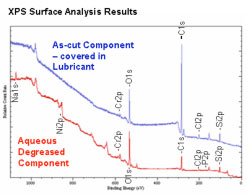XPS Evaluation of Chemical Cleaning Processes
Typical Applications Case Study:
Effectiveness of an aqueous degreasing process evaluated and improved by XPS.

XPS is frequently used to determine how well a chemical cleaning process is performing. A small nickel-chromium based metallic component is routinely cleaned using an aqueous degreasing process and subsequently undergoes a cutting process using an organic lubricant. If this lubricant remains on the surface of the metallic component in significant quantities, it not only interferes with the ease of laser welding to another subcomponent, but also renders the product unfit for functional use.
It is possible to identify if the component has been cleaned or not using optical microscopy (as shown below) However, if the component is partially cleaned it will appear very similar to a fully cleaned component.
Since XPS only analyses the top few atomic layers of a material it is ideal for evaluating and tuning the effectiveness of the aqueous degreasing process (process times, concentrations, use of agitation and ultrasonics). XPS can be equally applied to solvent degreasing, chemical etching and subsequent rinsing processes too.

XPS was carried out on the Ni-Cr metallic components before and after an aqueous degreasing process to evaluate the effectiveness of this cleaning process. From the XPS analysis before after cleaning it is possible to conclude the following:
- The aqueous degreasing has removed the majority of the surface hydrocarbon from the cutting fluid and chlorine from manual handling revealing the underlying nickel and chromium from the cleaned component surface
- Since the surface chromium can be seen prior to cleaning and there is a steep inelastic background where the major nickel peaks should be, it is likely that the remnant lubricant is less than a few nm thick. Results indicate that the lubricant is likely to be a continuous over-layer rather than a patchy / discontinuous layer
- Trace levels of calcium, phosphorus and nitrogen are also present which highlights the rinsing off of the aqueous degreasing solution was incomplete. The presence of calcium in particular signifies the poor purity of water being used to either make up the degreaser or rinse off the degreaser. It is likely that town water rather than demineralised water has been used and so the rinse water should be changed to demineralised water, which can be an expensive option with large products or with a high volume of products. A better alternative is to introduce brief demineralised water after a more comprehensive town water rinse which gets rid of the majority of the detergent
XPS can be used to tune the cleaning and rinsing processes minimising harmful residuals and improving the welding process yields and eliminating downstream functional issues.
Our site expert on XPS is Dr Stephen Jenkins.

